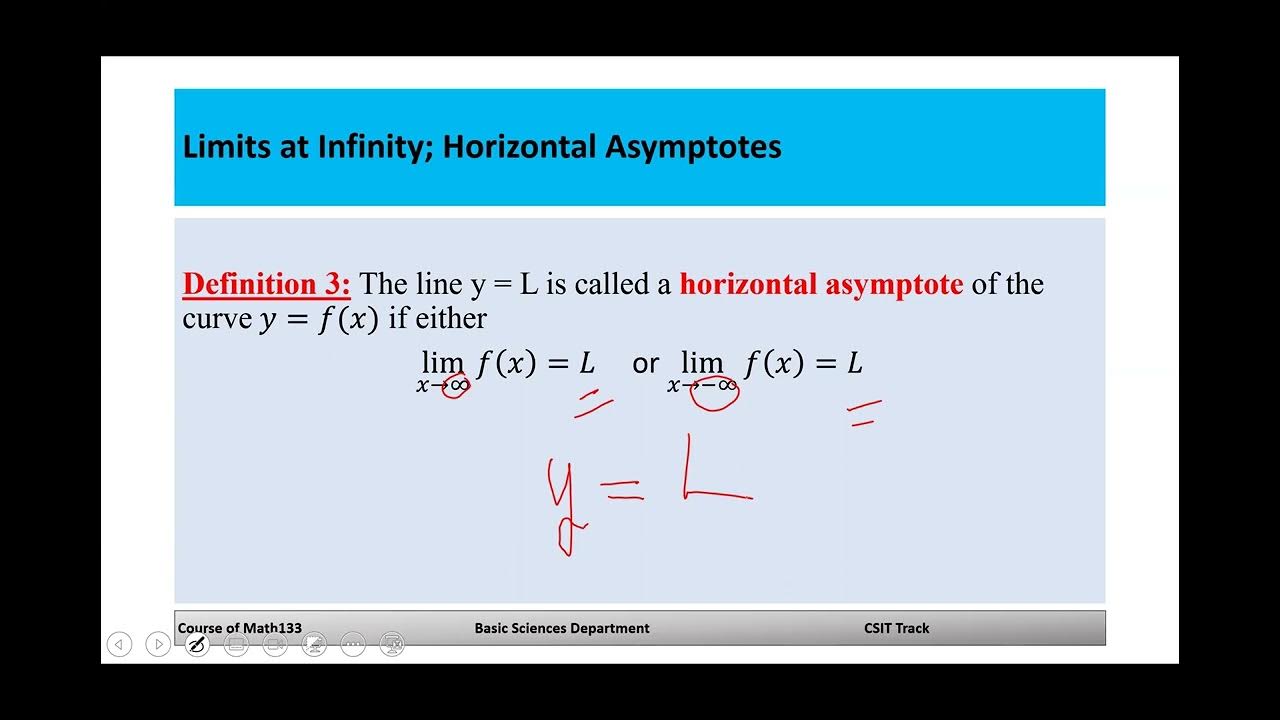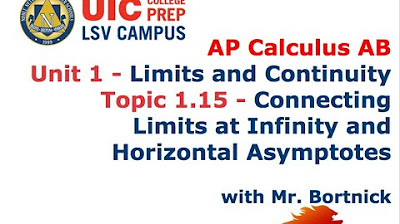Math 1325 Lecture 9 2 - Continuous Functions & Limits at Infinity
TLDRThis lecture on section 9.2 delves into the concept of limits at infinity and the continuity of functions. A function is considered continuous if its graph is smooth, without gaps or jumps. Continuity at a point C is determined by three criteria: the existence of f(C), the existence of the limit as X approaches C, and the limit matching the value of f(C). The domain of a function is pivotal in identifying discontinuities, such as zeros in the denominator of a fraction. The lecture also covers interval and set notation for representing ranges of X values and provides methods to evaluate limits at infinity using basic rules for rational functions. Examples are given to illustrate the process of finding limits and identifying asymptotes, both horizontal and vertical, which are lines that a function approaches but never reaches. The importance of understanding these mathematical concepts is emphasized for a deeper comprehension of calculus.
Takeaways
- 📈 A function is considered continuous if its graph is smooth without holes or jumps.
- 🔍 To prove continuity at a point C, a function must satisfy three conditions: existence of f(C), existence of the limit as X approaches C, and the limit equals f(C).
- ⛔ If any of the three continuity conditions are not met, the function is discontinuous at that point.
- 🚫 For rational expressions, zeros are not allowed in the denominator, and negative numbers under square roots are not permitted.
- 📌 To find where a function is discontinuous, set the denominator equal to zero and solve for X.
- 📊 Interval notation uses brackets to include values and parentheses to exclude them, representing ranges along the X-axis.
- 🔢 Set notation defines a range with a squiggly bracket, a straight vertical line, and an equation or description.
- 📐 Polynomials are continuous for all values, while rational functions are continuous except where the denominator equals zero.
- 🔁 Piecewise functions require checking for continuity at the break points in the intervals.
- 🧮 To evaluate limits at infinity, apply basic rules such as dividing by the largest power of X for rational equations.
- 🏁 A horizontal asymptote is a line y=B that the function approaches as X goes to positive or negative infinity.
- 🔍 A vertical asymptote occurs where the function's Y values approach positive or negative infinity at a specific value of X.
Q & A
What is the definition of a continuous function?
-A function is continuous if it has a smooth graph without any holes, gaps, or jumps. You can draw the entire graph without lifting your pencil from the graph paper.
What are the three criteria a function must meet to be considered continuous at a point C?
-For a function to be continuous at a point C, it must: 1) have a value for f(C), 2) have an existing limit as X approaches C, and 3) have the limit as X approaches C equal to the Y value or f(C).
What is the significance of the domain of a function in determining continuity?
-The domain of a function indicates the values of X that are allowed. Discontinuities can occur where the function is not defined, such as zeros in the denominator of a fraction or negative numbers inside the square root.
How do you find the values of X where a function is discontinuous due to a hole in the graph?
-To find where a function is discontinuous due to a hole, set the denominator of the function equal to zero and solve for X.
What are the two types of notations used to write intervals or ranges along the x-axis?
-The two types of notations are interval notation, which uses square brackets and parentheses to indicate included and excluded values, and set notation, which uses a squiggly bracket and a straight vertical line followed by an equation or description.
How can you determine if a rational function is continuous?
-A rational function is continuous at all values except those that make the denominator equal to zero. You can set the denominator equal to zero to find these discontinuities.
What are the basic rules for evaluating limits at infinity for rational equations?
-The basic rules are: 1) If there are only numbers in the numerator and X to any power in the denominator, the limit will equal 0. 2) If there is just X or X raised to a power in the denominator, the limit does not exist as it grows to positive or negative infinity.
How do you find the limit of a rational function as X approaches infinity?
-To find the limit at infinity, divide each term in the numerator and each term in the denominator by the largest power of X, then simplify to find the limit.
What is a horizontal asymptote and how is it determined?
-A horizontal asymptote is a line y equals a constant or f(X) equals a constant, which is the same value as the limit at infinity for the function. If the limit as X approaches positive or negative infinity of f(X) equals B, then the line y equals B is the horizontal asymptote of f(X).
What is a vertical asymptote and how can you identify it?
-A vertical asymptote is a line x equals a specific value where the function's Y values approach positive or negative infinity. It can be identified by observing the graph where the function curves up and down to both infinities at a specific X value.
What is the role of factoring in evaluating the continuity of a rational function?
-Factoring helps to identify the values of X that make the denominator zero, which are points of discontinuity. Even though the original function might be simplified, when considering continuity, the original equation must be used to find these points.
How can you determine if a piecewise function is continuous at the break point?
-To determine continuity at the break point, plug the break value into each piece of the piecewise function and solve. If the one-sided limits from both sides of the break point are not the same, the function is not continuous at that point.
Outlines
📈 Understanding Continuity and Limits
This paragraph introduces the concept of continuity in functions, explaining that a function is continuous if its graph is smooth without any gaps or jumps. It outlines three criteria for continuity at a point C: existence of the point f(C), the limit as X approaches C must exist, and the limit as X approaches C must equal the function's value at C. The paragraph also discusses how to determine the domain of a function and identify points of discontinuity, such as when the denominator of a fraction is zero. It concludes with an explanation of interval and set notation used to express the domain and ranges of functions.
🔍 Evaluating Continuity and Limits at Infinity
The second paragraph delves into how to assess the continuity of more complex functions, such as rational expressions, and how factoring can simplify the process. It emphasizes the importance of considering the original equation when checking for continuity, not a simplified version. The paragraph explains how to find values that cause discontinuity by setting factors equal to zero and solving. It also covers different types of functions (rational, polynomial, and piecewise) and their continuity characteristics. Additionally, it teaches how to evaluate limits as X approaches infinity using basic rules and how to apply these rules to rational equations by dividing each term by the largest power of X.
📊 Limits at Infinity and Asymptotes
The final paragraph focuses on calculating limits as X approaches positive or negative infinity for rational equations. It illustrates how to simplify expressions by dividing each term by the highest power of X present. The paragraph provides examples to show how this process leads to determining the limit's value or concluding that it does not exist. It also introduces the concept of asymptotes, explaining both horizontal and vertical asymptotes. A horizontal asymptote is a constant value that the limit approaches as X goes to infinity, while a vertical asymptote occurs where the function's output tends toward infinity at a specific X value. The paragraph concludes with an example graph demonstrating these concepts.
Mindmap
Keywords
💡Continuity
💡Limit
💡Domain
💡Interval Notation
💡Set Notation
💡Rational Expression
💡Polynomial
💡Piecewise Function
💡Asymptote
💡One-Sided Limits
💡Factoring
Highlights
A function is considered continuous if it has a smooth graph without any holes, gaps, or jumps.
Three criteria must be met for a function to be continuous at a point C: existence of f(C), existence of the limit as X approaches C, and the limit being equal to the value of f(C).
The domain of a function and values outside the domain can help determine continuity, especially for fractions where zeros are not allowed in the denominator.
Interval notation and set notation are two ways to represent ranges along the x-axis, with different symbols to indicate included or excluded values.
Rational functions are continuous everywhere except where the denominator equals zero, while polynomials are continuous for all values.
Piecewise functions require checking at the break in intervals to evaluate continuity.
To find the limit as X approaches a specific value, plug that value into the function and compare the left and right-sided limits.
Basic rules for evaluating limits at infinity include recognizing when a limit equals zero or does not exist due to the function's unbounded growth.
For rational equations, divide each term by the largest power of X to evaluate limits at infinity analytically.
A horizontal asymptote is a line y=B where B is the limit of the function as X approaches positive or negative infinity.
A vertical asymptote occurs where the function's values approach positive or negative infinity at a specific value of X.
The existence of asymptotes can be determined by examining the behavior of the function as X approaches certain values.
The concept of limits is crucial in calculus for understanding the behavior of functions at particular points or as they approach infinity.
Continuity is a fundamental property of functions that affects their graphical representation and mathematical analysis.
The use of interval and set notation is essential for clearly defining the domain and range of functions.
Factoring can simplify the process of determining where a rational function is discontinuous by setting the denominator equal to zero.
The behavior of functions at breaks in piecewise functions is critical to establish continuity across different intervals.
Homework exercises are recommended to practice evaluating continuity, limits, and identifying asymptotes.
Transcripts
Browse More Related Video

Math 133 Lecture 2 6

Business Calculus - Math 1329 - Section 1.5 (and 1.6) - Limits and Continuity

Types of discontinuities | Limits and continuity | AP Calculus AB | Khan Academy

Continuity!

1.2 - Algebraic Limits and Continuity

AP Calculus AB - 1.15 Connecting Limits at Infinity and Horizontal Asymptotes
5.0 / 5 (0 votes)
Thanks for rating: